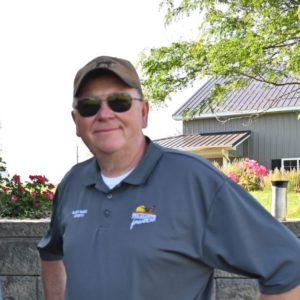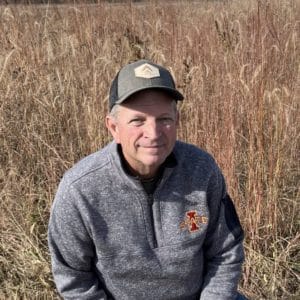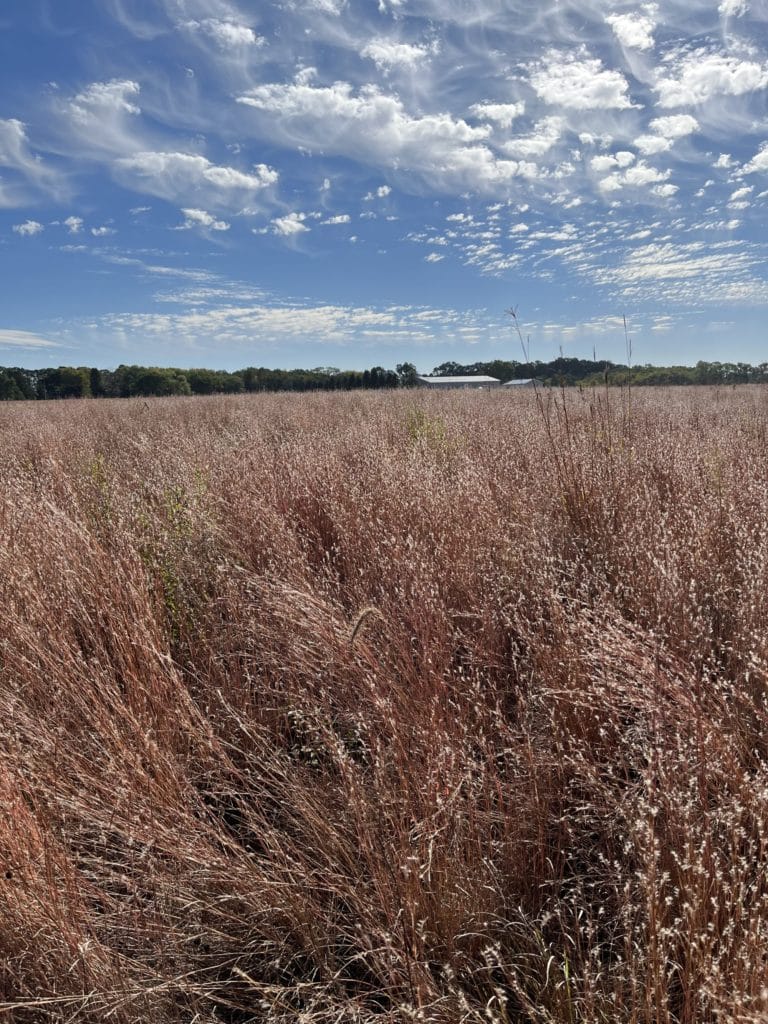Neighbors in Conservation
For two eastern Iowa farmers, conservation has fostered connection – along with personal and financial rewards.
Steve Robisky and Chuck Hesse have been neighbors in eastern Iowa for nearly 20 years. But it wasn’t until 2016, when Chuck rented 59 acres from Steve, that the two got to know each other better. Since then, they’ve found their paths crossing more as each has embarked on similar – but different – conservation journeys.
Their farms, near the Cedar River in Black Hawk County, Iowa, both offer serene views of rolling, tree-covered hills. Steve’s farm, 700 acres first purchased in 2005 and added to over the years, is scattered across several counties on the west side of the river. It’s almost exclusively dedicated to conservation, apart from about 100 acres currently in corn, beans and hay.
“I like conservation. I like everything about it,” Steve says. “I like clean air. I like clean water. I like snow that stays white because it doesn’t get dirt blown all over it.”
On the east side of the river, Chuck’s farm is a sprawling 1,200 acres, half in corn and the other half in beans. Chuck owns some of those acres and rents others.
“I probably travel a 12-mile radius on my rented and owned land, and I know every turn,” he says. “I know where the soil types change and where the land rises or falls. When you’re harvesting the crop or doing any work, there’s pride there.”
Renting land from Steve let Chuck see firsthand how Steve was integrating conservation practices. Observing Steve’s commitment to conservation – both for the environmental benefits and the potential economic incentives – planted the seed for Chuck to explore similar strategies on his own land.
As they each continue to work the land in their own ways, their parallel paths in conservation are converging, showing how neighboring farmers can inspire and influence one another, even when their approaches differ.
Connecting Through Conservation
Steve grew up on a family farm specializing in hogs, corn and soybeans. But seeing the struggles of the 1980s farm crisis, he didn’t feel confident about the future of farming. He forged a career off the farm, starting in the seed and pet food business in 1986 and switching to Deere and Co. in 1990, where he worked until retiring in 2020.
He still wanted to make a living off the land, however, and in 2005, Steve started buying land. Later, he started exploring ways to profitably use conservation practices on those acres, as well as on inherited land. That search led him to discover various federal and private programs that pay farmers for conservation efforts.
Part of his thinking is based on simple crop economics. In late November 2023, for instance, the U.S. Department of Agriculture estimated the average cost to plant, grow and harvest corn would be around $856 per acre in the 2024 crop year. To break even, farmers would need to yield between 180 and 200 bushels per acre.
“But in conservation,” Steve says, “there are programs that can make $255 per acre without all the inputs, putting that land ahead in profit margins.”
Beyond the numbers, however, land stewardship is a key part of Steve’s farming goals. Between 2015 and 2021, he worked to transition row crop land into native prairie.
Chuck, meanwhile, first noticed changes to Steve’s farm in 2016, while renting from him. He recalls driving past his neighbor’s land and seeing flowers beginning to bloom across vast swaths of Steve’s farm. Intrigued, Chuck asked Steve about it.
Steve explained his plan to make money off the land by enrolling it in the federal Conservation Reserve Program, which provides annual rental payments to landowners who convert environmentally sensitive cropland to vegetative cover.
Chuck admired the beauty of Steve’s newly established prairie and approached Steve for advice on creating a conservation plan for his own farm. He’d been thinking of ways to increase conservation, but knew he didn’t want to remove most of his land from production as Steve had. Instead, Chuck was inspired to stop planting his cash crop in marginal acres – areas of his farm that didn’t make enough profit to justify the costs associated with keeping them in production.
“I have variable soil types on my farm and that really affects harvest numbers,” Chuck says.
“I used data from my combine and overlaid that with a map of the farm. I noticed that, at harvest, certain areas would do poorly five or six times over a 10-year period.”
Balancing Conservation With Economics
Armed with that insight, Chuck realized those areas of his farm, about 22 acres, would be better used for habitat. He reached out to Steve for advice. Steve recommended a seed mix used for Conservation Reserve Program plantings called CRP 42 Prairie Mix – and he offered to plant those acres for Chuck. In 2017, Steve seeded the first 8 acres of Chuck’s land using CRP cost-share, followed by another 14 acres later in the year.
Today, Chuck’s farm also boasts colorful blooms and diverse pollinator habitat, which borders his main crops.
The land Chuck removed from production was also eligible to enroll into CRP, which he did in 2017. The program offers cost-share to prepare, seed and mow the land, and farmers often receive a sign-on bonus for joining. Chuck says the conservation rental payments he now receives on those acres make them more profitable than they had been as cropland.
“I realized I was throwing $200 to $300 of [cash crop] seed into this sandy area, and on zero-harvest years, I was out $300 [per acre],” Chuck says. “Now, the rental payments through various CRP programs guarantee some income on those acres.”
For Steve, this financial aspect is an important facet of conservation work. His approach to habitat conservation is guided by the commonly used analogy of a three-legged stool. For conservation plans to be robust, he says, they must be environmentally sustainable, have a positive impact on people and provide a financial return. On his land, Steve has seen a return on investment of 5.5% per acre, or $200-$300 per acre, after converting around 90% of his land to habitat.
Environmental sustainability, another leg of the stool, involves keeping the land healthy long into the future. “It takes around 100 years to make an inch of topsoil – and that’s if there is native tallgrass prairie on it,” Steve says. “Rebuilding these areas is one way we can assure the future of agriculture in the state.”
Both Steve and Chuck have seen the benefits of their conservation efforts – the third leg of the stool. “The soil on my production acres has additional nutrients being added to it,” Chuck says. “Plus, there are so many animals now. I have a lot of pheasant, deer and other wildlife using the CRP acres. Wildlife on the land also improves that land.”
Steve says, “I can tell you, when people see an intermix of conservation practices, clean snow in the winter or a deer or turkey, it leaves a positive impression on people, and not just those farming.”
Get Help Taking Marginal Acres Out of Production
Interested in restoring your own marginal acres? PFI has teamed up with Stephanie Nelson, the Iowa precision agriculture and conservation specialist for Pheasants Forever. She helps farmers analyze yield data to identify acres better suited for habitat than crop production.
“Chuck Hesse practiced precision conservation by evaluating his farm’s profitability at a subfield level, improving his bottom line while creating habitat,” Stephanie says. “This practice can benefit anyone, and we offer resources like CRP to help farmers get started.”
To learn more about technical support and unique incentives, visit pheasantsforever.org or contact Stephanie Nelson at snelson@pheasantsforever.org.



